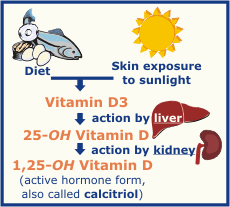The Nutrition Information Centre of the
University of Stellenbosch (NICUS)
 Nutrients
Nutrients
Vitamins: Vitamin D
What is it?
Vitamin D is a fat-soluble vitamin that exists in various forms. Some forms are relatively inactive in the body, and have limited ability to function as a vitamin. Exposure to sunlight is an important source of vitamin D. Ultraviolet (UV) rays from sunlight trigger vitamin D synthesis in the skin. The liver and kidney help convert vitamin D to its active hormone form, also called calcitriol.
Functions - what does it do?
Vitamin D plays a critical role in the body's use of calcium. The vitamin D hormone helps increase absorption of calcium from the intestine and it reduces excretion of calcium from the kidney. It promotes bone mineralisation (depositing calcium in the bone) and maintains bone density together with other nutrients (e.g. phosphorous and calcium), and hormones.
Requirements - How much do we need?
|
Adequate Intake* (AI)
(aµg/day) |
Life-Stage (years) |
Males |
Females |
0 - 8 | 5 | 5 |
9 - 18 | 5 | 5 |
9 - 50 | 5 | 5 |
51 - 69 | 10 | 10 |
Ages 70 + | 15 | 15 |
Life-Stage (years) |
Pregnancy |
Lactation |
18 and younger | 5 | 5 |
19 - 30 | 5 | 5 |
Ages 31 - 50 | 5 | 5 |
a1 µg vitamin D = 40 International Units (IU) |
*Adequate Intakes (AI) are used as no RDA is established. The AI is a recommended daily intake level based on observed or experimentally determined approximations of nutrient intake by a group of healthy people who are assumed to be maintaining an adequate nutritional state. |
Sources - Where is it found?
Sunlight. Our skin makes vitamin D when the skin is exposed to sunlight. The amount of sun exposure needed to produce vitamin D depends on the extent of the pigmentation of the skin and age. Young people with light coloured skin need about 10 minutes per day of casual sun exposure of their face and hands. People with dark skin may need 20 minutes of sun exposure.
Dietary Sources. Only a few foods naturally contain significant amounts of vitamin D, including fatty fish and fish oils. Other dietary sources include fortified milk and margarine, liver, butter, cream and egg yolks.
Deficiency - When you have too little
A deficiency of vitamin D can occur when: -
The action of vitamin D increases the amount of calcium and phosphorous deposited in bones. A deficiency in vitamin D decereases the deposition of these minerals making bones weak, brittle and soft causing them to bow under pressure, such as bearing weight. A child with these symptoms has the disease rickets. Symptoms also include enlarged head, joints, and rib cage, flattening of the back of the skull, and a deformed pelvis.
An adult disease similar to rickets is osteomalacia, which means soft bones. It results when calcium is removed from the bones to make up for a lack of absorption of calcium form the gut or poor conservation by the kidneys. This can result from vitamin D deficiency. Bones then lose their mineral content and become porous, weak and fragile.
Adults with limited sun exposure may also develop osteomalacia. This occurs most often in older adults as the ability of skin to synthesise or of the kidneys to convert vitamin D to its active form decreases as we age. The elderly are often bedridden and immobile, making it difficult for them to get sufficient direct sun exposure.
Individuals who have reduced ability to absorb dietary fat (fat malabsorption) may need extra vitamin D because it is a fat soluble vitamin. Symptoms of fat malabsorption include diarrhoea and greasy stools.
Combinations of sun exposure (about 20 minutes per day) and vitamin D intake may be used to prevent vitamin D deficiency. Sometimes a supplement may be necessary. For older people, a supplement of 10 to 20 µg should suffice. Consuming more than 25 µg of vitamin D per day should only be done under the supervision of a physician.
Toxicity - When you have too much
As little as 5 times the RDA of vitamin D taken regularly can cause an overdose and produce signs of poisoning. Toxicity can result in excess calcium in the blood, which is eventually deposited in the kidneys and other organs. Calcium deposits in organs cause disturbances in metabolism and cell death.
| Upper Limit+ (aµg/day) |
Life-Stage (years) | Males | Females |
0 - 1 | 25 | 25 |
1 - 8 | 50 | 50 |
9 - 18 | 50 | 50 |
Ages 19+ | 50 | 50 |
Life-Stage (years) | Pregnancy | Lactation |
18 and younger | 50 | 50 |
19 - 30 | 50 | 50 |
Ages 31 - 50 | 50 | 50 |
a1 µg vitamin D = 40 International Units (IU) |
+Upper Limits (UL) = The maximum level of daily nutrient intake that is likely to pose no risk of adverse effects. Unless otherwise specified, the UL represents total intake from food, water, and supplements. ND = Not determinable due to lack of data of adverse effects in this age group and concern with regard to lack of ability to handle excess amounts. Source of intake should be from food only to prevent high levels of intake. |
Other signs of vitamin D toxicity include: slow mental and physical growth, weakness, hypertension, loss of appetite, increased thirst, loss of weight, diarrhoea and vomiting.

